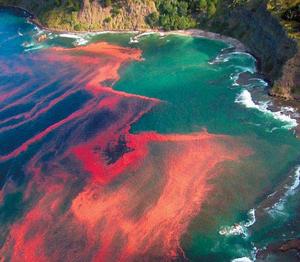
The coastal ocean can be likened to a parfait of enormous proportions. Rather than being homogeneous, it’s a layered affair of water, nutrients and organisms.
Among the layers are those that contain large concentrations of plankton. These layers are usually just a few yards below the surface, only a few feet thick but potentially miles long. They serve as ecological hot spots, providing food for other creatures. But they can also be the scene of huge algal blooms that cause toxic red tides.
Just how those plankton layers form has been unclear. Now in a paper in Science, William M. Durham and Roman Stocker of the Massachusetts Institute of Technology and John O. Kessler of the University of Arizona have shown that plankton’s swimming and shape play a role.
Stocker, who studies the large-scale consequences of the motility of plankton, said that the single-celled organisms tended to swim upward during the day and down at night. If the water is still, they just go straight up and down.
But ocean currents set up layers of faster- and slower-moving water. At the boundary between two layers, shear forces occur that act on the plankton, causing them to swim in an inclined direction and, if the forces are strong enough, making them tumble and spin. Because they are no longer swimming upward, the tumbling plankton become trapped at this boundary, joined by more and more plankton as they swim up into the zone. The findings should help in efforts to forecast red tides, Stocker said.
``It points oceanographers in the right direction in terms of what they should measure to predict these things,” Stocker said. ``They need to measure vertical shear, and measure something about cell morphology.”— New York Times News Service
Among the layers are those that contain large concentrations of plankton. These layers are usually just a few yards below the surface, only a few feet thick but potentially miles long. They serve as ecological hot spots, providing food for other creatures. But they can also be the scene of huge algal blooms that cause toxic red tides.
Just how those plankton layers form has been unclear. Now in a paper in Science, William M. Durham and Roman Stocker of the Massachusetts Institute of Technology and John O. Kessler of the University of Arizona have shown that plankton’s swimming and shape play a role.
Stocker, who studies the large-scale consequences of the motility of plankton, said that the single-celled organisms tended to swim upward during the day and down at night. If the water is still, they just go straight up and down.
But ocean currents set up layers of faster- and slower-moving water. At the boundary between two layers, shear forces occur that act on the plankton, causing them to swim in an inclined direction and, if the forces are strong enough, making them tumble and spin. Because they are no longer swimming upward, the tumbling plankton become trapped at this boundary, joined by more and more plankton as they swim up into the zone. The findings should help in efforts to forecast red tides, Stocker said.
``It points oceanographers in the right direction in terms of what they should measure to predict these things,” Stocker said. ``They need to measure vertical shear, and measure something about cell morphology.”— New York Times News Service
No comments:
Post a Comment